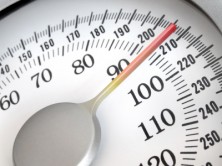How to Lose Two Pounds Per Week

Some people lose a bit more at first, which can happen if you lose “water weight” instead of fat. And people who carry a lot more weight can lose a bit more than two pounds a week safely.
What’s important is that you aim for a safe and realistic amount of weight to lose -- like one to two pounds a week. Losing more than that can create health issues and can set you up for failure. It likely took years for you to gain the weight, so it’s going to take time to lose it. There are lots of unhealthy habits that need be replaced with healthy ones. Replacing the old habits takes time.
How to Lose 1 to 2 lbs a Week -- The Basic Formula
To lose weight (fat), you need to create what’s called a calorie deficit. See, you gained weight because you created a calorie surplus (eating more calories than your body burned). To reverse that, you need to create a calorie deficit -- eating fewer calories than your body burns in a day.This way, your body will dig into your body fat to get the extra energy it needs.
See: Calorie Deficit Calculator
Theoretically, to gain one pound of fat, you’d have to eat an extra 3500 calories. Therefore, to lose one pound of fat in a week, you’d have to eat 3500 fewer calories than your body needs for that week.
To lose two pounds of fat in a week, you’d have to eat 7000 fewer calories than your body needs for that week. (You'd multiply 3500 calories times 2 to get 7000 calories.)
It sounds like a lot at first, but if you break it down into daily calorie goals, it’s much easier to digest. (See what I did there?)
Daily Calorie Deficit to Lose 1lb Per Week
3500 / 7 = 500 fewer calories per day
Daily Calorie Deficit to Lose 2lbs Per Week
7000 / 7 = 1000 fewer calories per day
You can create a calorie deficit in three ways:
- Eating fewer calories (less food).
- Burning more calories (more exercise).
- A combination of eating fewer calories and burning more calories through exercise.
A combination of eating fewer calories along with moving more is usually the best for most people. It’s difficult to decrease the amount of food you eat by 500 to 1000 calories a day, just as it’s difficult to increase your exercise by 500 to 1000 calories burned a day, especially if you don’t exercise at all.
To lose 1lb a week through a combination of eating fewer calories and exercising more, you could eat 250 few calories per day and exercise enough to burn an extra 250 calories.
-250 + -250 = -500 calorie deficit
To lose 2lbs a week through a combination of eating fewer calories and exercising more, you could eat 500 few calories per day and exercise enough to burn an extra 500 calories.-500 + -500 = -1000 calorie deficitSee: Calories Burned Database
Now, that’s a pretty basic formula -- and there’s much more that can come into play (hunger, cravings, macronutrients, micronutrients). But this gives you a general idea of what it takes to lose weight: you need to create a calorie deficit.
The question then becomes...
How Many Calories Should I Eat in a Day to Lose 1 to 2lbs a Week?
How many calories you should eat in a day to create a calorie deficit to lose 1 to 2lbs a week depends on a variety of factors, including your height and current weight, and your activity level.You need to find out how many calories you need to eat in a day to keep your weight stable (your maintenance weight).
From that number, you would subtract either 500 or 1000 calories (without ever going below 1200 calories a day for women and 1800 calories a day for men) Or you could subtract anywhere from 10% to 25% of the total calories.
Don't like math? You can use my calorie deficit calculator instead! It will easily calculate a calorie deficit for you.
Let's take an example. Let's take a 5’ 5” 200lb, 50 year old woman who is lightly active. Plug those numbers into the calculator up above. And let's round those numbers up to make the math easier.
She would need approximately 2200 calories to maintain her weight. That is, if she ate 2200 calories per day, she wouldn’t gain weight and she wouldn’t lose weight. (Theoretically!)
If she wanted to lose 1lb per week, she could aim for a calorie goal of 1700 calories per day to create a calorie deficit.
2200 calories - 500 calories = 1700 calories per day.
If she wanted to lose 2lbs per week, should could aim for a calorie goal 1200 calories per day to create a calorie deficit.
2200 calories - 1000 calories = 1200 calories per day.
But 1200 calories per day is getting pretty low as a calorie goal. And in those conditions, she will likely be hungry -- which could backfire by giving her cravings which would result in overeating. And that? Pushes her further away from her weight loss goals.
See: 3 Reasons Why Eating Less Than 1000 Calories a Day is a Waste of Time
She’d have to be eating nutrient-dense foods to make sure she was getting important nutrients, like vitamins and minerals, and enough carbs, protein and fat.
A low calorie goal is certainly not impossible but, for most people, it’s too much of a change and it's not sustainable. You can't keep it up for any length of time.
So, you can see why a combination of eating fewer calories and adding in more exercise is an easier option to lose weight.
If that same woman was moderately active -- meaning if she started exercising more -- she would need approximately 2500 calories to maintain her weight.
If she wanted to lose 1lb per week, she could then aim for eating 1700 calories per day.
2500 calories - 500 calories = 2000 calories per day.
If she wanted to lose 2lbs per week, should could aim for 1500 calories per day.
2500 calories - 1000 calories = 1500 calories per day.
See how that works? It’s about finding the right combination of food + exercise = fat loss.
Lifestyle Changes to Make to Lose 1lb to 2lbs a Week
As a weight loss coach, I like to focus on helping my clients make lifestyle changes, from making more time for themselves to eating healthy foods they love to understanding their relationship with food. I help my clients move away from “diet rules” to relying on themselves to make the best choices for them (and yup, that can STILL include things like chocolate or wine).There are so many changes you can make to your lifestyle to help you lose one to two pounds a week. It can be difficult to decide where to start.
My mantra is:
Start wherever you are.
Use whatever you have.
Do whatever you can.
You could do something as simple as walking every day. That same 200lb woman could walk 45 minutes a day to burn 250 calories.
See: Calories Burned While Walking
You could reduce your liquid calories. Replacing fruit juices and calorie-dense fancy coffees can reduce the amount of calories you drink in day from 100 to over 500 calories a day.
See: Are Your Liquid Calories Making You Gain Weight?
You could focus on hand-size portions to help understand how reducing your portions -- while still eating healthy and filling foods -- can help you to create a calorie deficit, so you can lose weight.
See: How Hand-Size Portions Can Help You Lose Weight
You could use my two simple strategies for weight loss: eating slowly and eating till 80% full.
See: Two Simple Strategies For Weight Loss
To safely lose one to two pounds a week, create a calorie deficit of 500 to 1000 calories a day through a combination of eating fewer calories and adding more exercise into your everyday routine. Do this by making changes to your lifestyle, moving from unhealthy habits to healthier habits that you are ready, willing and able to do every day.
If you'd like help making healthy lifestyle changes to lose weight, that is something that I specialise in as a weight loss coach. No diet rules. No restrictions. No eating foods you don't like! Click here to find out how I can help you.
References
https://www.ideafit.com/fitness-library/acsm-on-weight-loss
https://acewebcontent.azureedge.net/continuingeducation/resources/4a5wy7yz/fss/Chapter3.pdf
